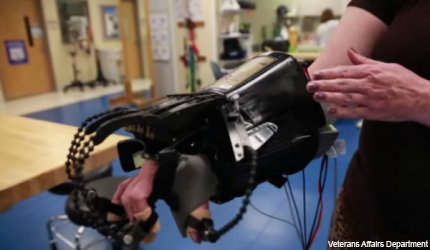Robotic glove can help tetraplegic veterans recover
VA is running trials on the FES Hand Glove 200, which helps patients complete their therapy sessions.

The robotic glove uses passive range of motion and functional electrical stimulation.
Scientists and medical personnel with the Veterans Affairs Department are using new robotics technology to help people with spinal cord injuries recover more quickly.
The Functional Electrical Stimulation Hand Glove 200, which combines active functional electrical stimulation with passive robotic bio-mechanic movement, enables patients to complete full therapy sessions even if their muscles tire quickly. As a result, muscle mass and strength could return more quickly than if they performed therapy exercises only until they became exhausted.
The FES Hand Glove 200 is the work of Randy Simmons, who spent a decade as a robotic engineer in the film business, working on “Jurassic Park,” “Mimic” and other movies, before devoting himself to using robotics in medical rehabilitation, according to a VA news release. The prototype device fits over the hand and is designed to improve strength and range of motion.
Medical teams at the James A. Haley VA Medical Center in Tampa, Fla., are testing the robotic glove with tetraplegic patients ranging in age from 18 to 85. The patients have spinal cord injury C4-6 and impairments of the upper extremities (the C numbers count down the vertebrae from the base of the skull; the higher up the vertebrae, the more likely it is that impairments occur).
An initial trial consisted of using the FES Hand Glove 200 for 30 minutes of passive range of motion exercises and 30 minutes of electrical stimulation in 24 sessions conducted over six weeks. The early results suggests that patients showed improvements in fine motor skills, dexterity, speed, range of motion and hand strength while experiencing decreased swelling, VA said. A second trial is underway.
The FES Hand Glove is another example in how military and other research labs are using new developments in robotics to improve medical care, rehabilitation and recover. Last year, the Food and Drug Administration approved the DEKA Arm System, the first prosthetic arm and hand that responds to muscle contractions and greatly improves dexterity for the user. The systems was developed with funding from the Defense Advanced Research Projects Agency, which recently awarded contracts to start on the next step—developing a prosthetic hand with a sense of touch.
NASA has been adapting exoskeleton technology to help people who have lost the use of their legs to learn to walk again. Doctors at Walter Reed National Military Medical Center are using robotics in surgery and an Air Force hospital last year used a robot to ensure rooms were clear of Ebola.




